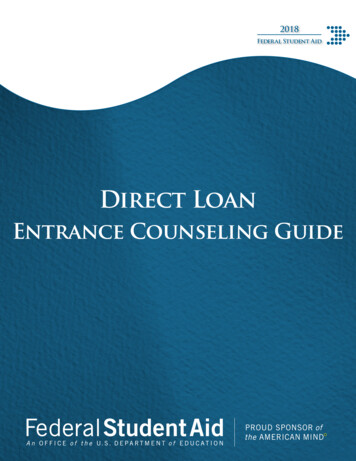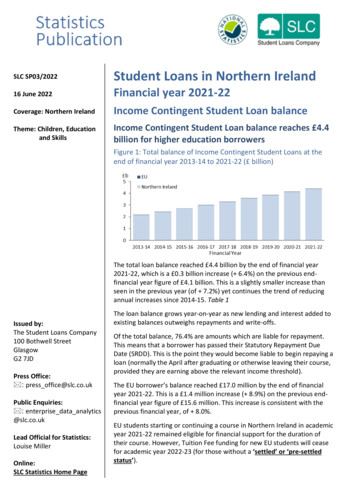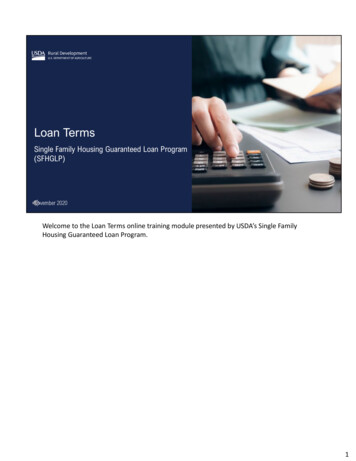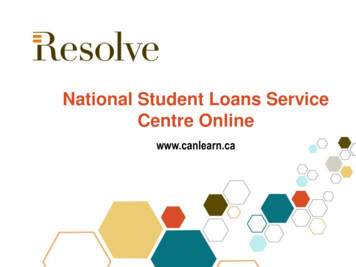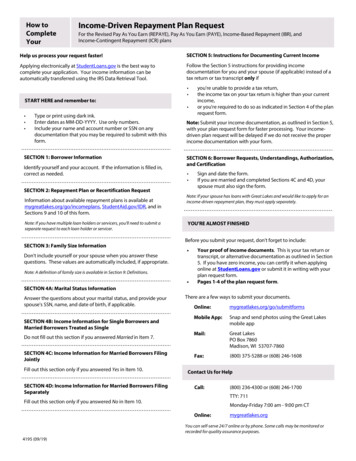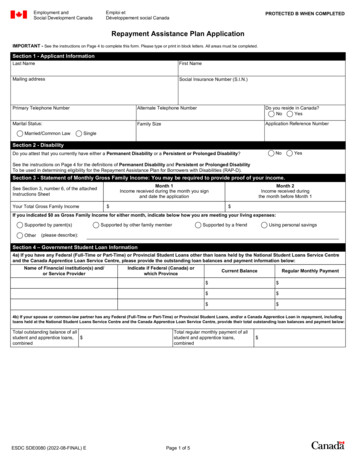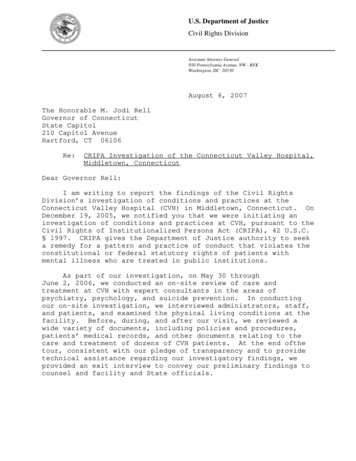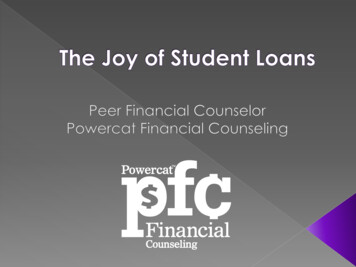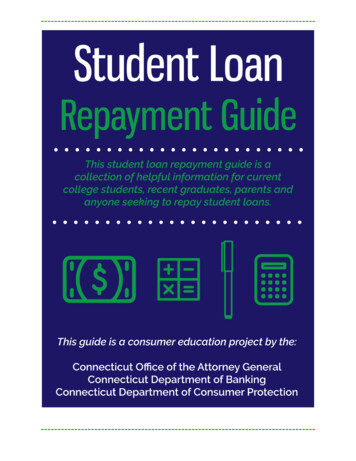
Transcription
WelcomeDear Borrower,Welcome to the Student Loan Repayment Guide, a collection of helpful informationfor current college students, recent graduates, parents and anyone seeking to repaystudent loans.This guide will help you understand your loans, rights, responsibilities, repaymentoptions and where to get more information. It also explains how your loan servicercan help you and how you should avoid being a victim of scams.The information in this guide applies to borrowers with federal loans. Private loans,such as those issued by a bank, credit union, or school, may be subject to differentrules.Student loan repayment can be difficult to understand. To help you, we haveincluded a useful Glossary of Terms used in this guide. We have also included aWeb Address Index with full web addresses from the guide.Although some general borrower tips are included, those looking for information onhow to pay for college should visit Student Financial Aid on the State of Connecticutwebsite.Finally, the guide is intended as a helpful starting point rather than a comprehensiveand definitive source for all information that may be relevant to a particular studentloan borrower. The information provided in here is current as of January 2016.This guide is a consumer education project by the:Thank you to the organizations belowfor use of information and links on their websites:U.S. Department of EducationConsumer Finance Protection BureauConnecticut Office of Higher Education1 Page
Table of ContentsTypes of Federal Student Loans: Page 3Your Payment Planning: Page 4Repayment Plans: Page 5Student Loan Servicers: Page 7Loan Forgiveness Programs: Page 8Defense to Repayment: Page 9Protecting Yourself from Scams: Page 10Glossary of Terms: Page 11Web Address Index: Page 142 Page
Types of Federal Student LoansThe U.S. Department of Education has two federal student loan programs:The William D. Ford Federal Direct Loan (Direct Loan) Program is the largestfederal student loan program. Under this program, the U.S. Department of Educationis your lender. There are four types of Direct Loans available:oDirect Subsidized Loans are loans made to eligible undergraduatestudents who demonstrate financial need to help cover the costs of highereducation at a college or career school.oDirect Unsubsidized Loans are loans made to eligibleundergraduate, graduate, and professional students, butthe student does not have to demonstrate financialneed to be eligible for the loan.oDirect PLUS Loans are loans made to graduate orprofessional students and parents of dependentundergraduate students to help pay for educationexpenses not covered by other financial aid.oDirect Consolidation Loans allow you to combine all of youreligible federal student loans into a single loan with a singleloan servicer.Interest ratesfor direct loansare fixed andthe amount isset annually byfederal law.The Federal Perkins Loan Program is a school-based loan program forundergraduates and graduate students with exceptional financial need. Under thisprogram, the school is the lender. At the time this manual was drafted, PerkinsLoans were no longer available to new borrowers. However, if you arecurrently in repayment, you may have one.Other options for borrowing in Connecticut:Connecticut Higher Education Supplemental Loan Authority is a quasi-publicstate authority created to help students and their families finance the cost of highereducation. CHESLA serves as an alternative source of loan funds for students in orfrom the State of Connecticut who do not qualify for need-based loans, need toborrow more than the maximum amounts provided by other loan programs, or seekother loan options and services. Loans from CHESLA are not federal loans.Where can I find more information on Types of Student Loans? Federal vs. Private Loans: U.S. Department of Education Federal Student Aid Office"Paying for College: Your Guide to Federal College Aid Programs" from the State ofConnecticut Office of Higher Education3 Page
Your Repayment PlanningYour repayment planning is an important part of making sure your loans are paid offon schedule. When you graduate, drop below half the credits you need to be full time,or withdraw from your academic program, you will receive a six-monthgrace period for your Direct Subsidized and Unsubsidized Loans.Your grace period begins the day after you stop attendingschool on at least a half time basis. Once your grace period ends,you must begin repaying your loan(s).Based on eligibility,borrowers can payloans back over 10, 15,or 30 years.Here are steps we recommend you take before your repayment period begins:Make a list of all your student debt using these resources.Federal Loans: Log into the National Student Loan Data SystemPrivate Loans: View a free copy of your credit reportDetermine what you can afford by making a monthly budget of income andexpenses.U.S. Department of Education Federal Student Aid Office has a budgeting toolyou can use.Select a repayment plan based on what you can afford, and your eligibility.Federal student loan borrowers have several repayment plan options youshould review before the end of your grace period. If no plan is selected duringyour grace period, you will be placed into the “standard repayment plan.” Thelonger your loans are in repayment, the more interest you will pay.You must repay your loans even if you don’t complete your education, can’t find a jobrelated to your program of study, or are dissatisfied with the education financed by yourloan.Where can I find more information on Repayment Planning? Repay Student Debt Web Tool: Consumer Financial Protection BureauRepayment Plans: U.S. Department of Education Federal Student Aid OfficeWhen you Graduate or Leave School: U.S. Department of Education Federal Student Aid OfficePrivate Loans: Borrowers should contact their loan servicer to discuss possible options to makerepayment more affordable.4 Page
Repayment PlansThere are many repayment plans for your student loans. Many of the repayment planswill be based on the type of loan you are paying back, and your current education andemployment situation.What repayment options are there for federal borrowers?1234551. Standard Repayment: A fixed amount of 50 or more is paid every month untilthe loans are repaid. This repayment plan lasts up to 10 years.2. Extended Repayment: Extended repayment is for a Direct Loan debt of morethan 30,000, acquired after Oct. 7, 1998. This repayment term is up to 25years. You would have a choice of: Fixed Payment: You pay the same amount each month. Graduated Repayment: Your payments start out low and increase everytwo years. This payment term is up to 10 years.3. Income Contingent Repayment (ICR): In this plan, monthly payments arecalculated each year on the basis of your adjusted gross income (AGI, plusyour spouse's income if you're married), family size, and the total amount ofyour Direct Loans each year. The maximum repayment period is 25 years.4. Income-Based Repayment (IBR): In this plan, the required monthly paymentis based on your income during any period when you have a partial financialhardship. Monthly payment may be adjusted each year. This repayment periodmay exceed 10 years.5. Pay as You Earn Repayment: This plan is for those who qualify for partialfinancial hardship. The payment amount may increase or decrease each yearbased on income and family size. Eligible student loans include Direct Loans aswell as certain types of Federal Family Education Loan Program loans.How do I enroll in or change my repayment plan? You can contact your student loan servicer to learn more about options forchanging your repayment plan.Visit the U.S. Department of Education Federal Student Aid Office to enroll in anincome-based repayment plan.If you are an active duty service member, you may beeligible for specific repayment benefits. You can find moreinformation through the Consumer Financial ProtectionBureau on Military Deferment.5 Page
What would my payments be under each repayment option?The U.S. Department of Education Federal Student Aid Office repayment estimator toolcan tell you what your payments would be based upon your actual loan information,including your repayment plan.Note: This calculator is made for borrowers who have not yet made theirfirst payments. If you have already begun repayment, the FSA recommendscontacting your servicer to get a more accurate estimate of what your newpayments would be under the different plans.Consolidating your loans:It may be simpler to combine all of your loans into onepayment. Longer repayment structures may lower yourmonthly payment. However, they may increase yourtotal interest costs over the life of the loan, and makeyour loan cost more.Private student loans arenot eligible for federal loanconsolidation, but certainfinancial institutions suchas banks and credit unionsmay offer refinancingprograms.If You Default:Failure to make payments on your loan can have serious consequences. Your loan firstbecomes delinquent if your monthly payment is not received by the due date. You areconsidered "in default" of most federal student loans if your loan is more than 270 dayspast due. Loans in default are subject to late fees, reasonable collection fees and costs,court costs, attorney fees and garnishment of wages, and/or state and federal taxrefunds.If you are behind on your loan payments, contact your loan servicer immediately to findout how to bring your account up to date. You can read more about getting up to dateon your loan repayment or loan rehabilitation with these resources: Loan Rehabilitation: U.S. Department of Education Student Aid Office Rehabilitation: Consumer Financial Protection BureauWhere can I find more information on Repayment Plans? Loan Consolidation: U.S. Department of Education Federal Student Aid Office Repayment Guidelines: U.S. Department of Education Federal Student Aid Office Federal Student Loan Consolidation: Consumer Financial Protection Bureau6 Page
Student Loan ServicersStudent Loan Servicers are companies that collect payments, respond to customer serviceinquiries, and do other administrative tasks associated with maintaining a student loan. Theymay be your original lender or a different company.What can servicers do to help you? The monthly bill you receiveAnswer questions about your student loanfor your student loanCounsel you on making your loan payments affordablerepayment will be fromDetermine available repayment plan optionsyour student loan servicer.Assist with loan consolidationProcess deferments and forbearancesProvide assistance with forgiveness, cancellation or discharge optionsHow do I find my student loan servicer? Federal Loans:o Visit National Student Loan Data System to look up your federal student loans anddetermine your federal student loan servicers.o Visit the Federal Student Aid Office Website for contact information for federal studentloan servicers. Private Loans:o If you have a private loan, contact your lender to determine who your student loanservicer is.What should I know about working with student loan servicers? Do not ignore letters from your loan servicers, and notify your loan servicers of anychange of address.Visit your loan servicer's website for contact and other information.When possible, communicate with your loan servicer in writing.Keep a log with the dates and details of your interactions with your loan servicer.Keep copies of all bills, receipts, letters, and e-mails from your loan servicer.Each loan has its own loan servicer. However, two or more of your loans may have thesame servicer.Servicers may change while paying off your loan.If you have any questions about information from your student loan servicer, youshould contact the Connecticut Department of Banking.Where can I file a complaint or get help to resolve a dispute against astudent loan servicer, third party student debt negotiator or debtcollector? Connecticut Department of Banking at 1.800.831.7225Consumer Financial Protection Bureau at 1.855.411.2372Where can I find more information about Student Loan Servicers? Understanding Loan ServicersAdditional Information about Loan ServicersWorking with Loan Servicers7 Page
Loan Forgiveness ProgramsLoan Forgiveness is the cancellation of all or some portion of your remaining federalstudent loan balance. If your loan is forgiven, you are no longer responsible forrepayment.Public Service Loan Forgiveness Program (PSLF)The PSLF Program is intended to encourage you to enter and continue to work fulltime in public service jobs. Under this program, you may qualify for forgiveness ofthe remaining balance due on your William D. Ford Federal Direct Loan Programloans after you have made 120 qualifying payments on those loans while employedfull-time by certain public service employers. Anynon-defaulted loan in the Direct Loan ProgramYou should consult with ais eligible for loan forgiveness.Teacher Loan Forgiveness Programtax professional todetermine how loanforgiveness may affect yourpersonal income taxes.The Teacher Loan Forgiveness Program encouragesindividuals to enter and continue in the teaching profession. Under this program, ifyou teach full time for five complete and consecutive academic years in certainelementary and secondary schools and educational service agencies that serve lowincome families, and meet other qualifications, you may be eligible for forgiveness ofup to a combined total of 17,500 on your Direct Subsidized and UnsubsidizedLoans and your Subsidized and Unsubsidized Federal Stafford Loans. If you haveDirect PLUS Loans only, you are not eligible for this type of forgiveness.Note: If you are enrolled in an income-based repayment plan, you may be eligiblefor loan forgiveness after 20 to 25 years. You can find more information from theU.S. Department of Education Financial Student Aid Office.Where can I find more information about Loan Forgiveness Programs? Public Service Loan Forgiveness Program Information (PDF)FAQs on PSLF (PDF)Forgiveness, Cancellation, & Discharge: U.S. Department of Education Federal StudentAid OfficeFor Borrowers: Consumer Financial Protection BureauFor Public Service Employers: Consumer Financial Protection BureauAmerican Student Assistance8 Page
Defense to RepaymentEligible borrowers may in some unusual circumstances apply for discharge ofsome or all of their loans by submitting a Borrower Defense Claim with the U.S.Department of Education. A Borrow Defense Claim is a way for you to potentially nolonger pay back your loan in the case you have experienced the circumstancesdescribed below.In what circumstances would I assert a Borrower Defense claim?Borrowers with federal Direct Loans are eligible to assert a claim for BorrowerDefense if they took out federal loans to attend a school that: Made false or misleading statements about the value of an educational programor the financing needed to pay for a program Committed other improper or unlawful acts or omissions that would give rise to acause of action against the school under applicable state lawHow do I make a Borrower Defense claim? The U.S. Department of Education is developing a streamlined claims processfor future use by borrowers wishing to assert a Borrower Defense claim. Onceavailable, the Department plans to provide additional information regarding thenew claims process on their website. If you choose instead to submit your claim before the new process is available,you may submit materials via email to FSAOperations@ed.gov or by mail to:Department of Education, PO Box 194407, San Francisco, CA 94119.A list of information you must include for all Borrower Defense Claims islisted on the Debt Relief for Corinthian Colleges Students page on theDepartment of Education Website.What types of relief may be available? Borrowers who successfully assert a Borrower Defense claim may be eligible toobtain various forms of relief, including the following:o An official decision that you do not have to repay all or part of the loan andassociated costs and feeso A change to your loan status saying you are not in defaulto An updated credit report that changes the negative information about yourloanWhere can I find more information about Defense to Repayment? U.S. Department of Education Report on Borrower DefenseDebt Relief for Corinthian College Students9 Page
Protecting Yourself from ScamsStudent loan borrowers may be targeted by scammers promising to help themmanage their student debt. Some signs of a student loan debt relief scam are: Charging illegal upfront feesRecurring monthly feesCharging for free government formsPressuring you into signing a Power of AttorneyauthorizationOfficial or governmental sounding names or logosWhere can I go with questions about student loan companies?Before you send any money or give personal financial information to companiesclaiming to be a third-party negotiator or debt collector, check with the ConnecticutDepartment of Banking or Connecticut Department of Consumer Protection.Where can I file a complaint?If you have paid money to an unlicensed company for help with loan consolidation,repayment plans, forbearance or deferment of payments, you should contact theConnecticut Department of Banking right away.Where can I find more information about Protecting Myself from Scams? A complete list of licensed debt collection and debt negotiation companies is availablefrom the Connecticut Department of Banking. Once on their website, click on “ConsumerCredit Licensing.”If you are uncertain whether a financial institution is legitimate, you may contact theConnecticut Department of Banking for a complete listing of all licensed lenders at1.800.831.7225.Contact the Connecticut Department of Consumer Protection at 1.800.842.264910 P a g e
Glossary of Termsfrom StudentAid.gov GlossaryCancellation: The release of the borrower's obligation to repay all or a designated portion ofprincipal and interest on a student loan. This is also called discharge or forgiveness of a loan.Consolidation: The process of combining one or more loans into a single new loan.Death Discharge: If you, the borrower, die, then your federal student loans will be discharged.If you are a parent PLUS loan borrower, then the loan may be discharged if you die, or if thestudent on whose behalf you obtained the loan dies.Default: Failure to repay a loan according to the terms agreed to in the promissory note. Formost federal student loans, you will default if you have not made a payment in more than 270days. You may experience serious legal consequences if you default.Deferment: A postponement of payment on a loan that is allowed under certain conditions andduring which interest does not accrue on Direct Subsidized Loans, Subsidized Federal StaffordLoans, and Federal Perkins Loans. All other federal student loans that are deferred will continueto accrue interest. Any unpaid interest that accrued during the deferment period may be addedto the principal balance (capitalized) of the loan(s).Direct Consolidation Loan: A federal loan made by the U.S. Department of Education thatallows you to combine one or more federal student loans into one new loan. As a result ofconsolidation, you will have to make only one payment each month on your federal loans, andthe amount of time you have to repay your loan will be extended.Direct Loan: A federal student loan, made through the William D. Ford Federal Direct LoanProgram, for which eligible students and parents borrow directly from the U.S. Department ofEducation at participating schools. Direct Subsidized Loans, Direct Unsubsidized Loans, DirectPLUS Loans, and Direct Consolidation Loans are types of Direct Loans.Discharge: The release of a borrower from the obligation to repay his or her loan.Discharge in Bankruptcy: If you file Chapter 7 or Chapter 13 bankruptcy, you may have yourloan discharged in bankruptcy only if the bankruptcy court finds that repayment would imposeundue hardship on you and your dependents. This must be decided in an adversary proceedingin bankruptcy court. Your creditors may be present to challenge the request.Federal Student Loan: A loan funded by the federal government to help pay for youreducation. A federal student loan is borrowed money you must repay with interest.FFEL Program: Federal Family Education Loan ProgramFederal Family Education Loan (FFEL) Program: Under this program, private lendersprovided loans to students that were guaranteed by the federal government. These loansincluded Subsidized Federal Stafford Loans, Unsubsidized Federal Stafford, FFEL PLUS Loans,and FFEL Consolidation Loans. Federal student loans under the FFEL Program are no longermade by private lenders. Instead, all new federal student loans come directly from the U.S.Department of Education under the Direct Loan Program.11 P a g e
Federal Perkins Loan: A federal student loan, made by the recipient's school, forundergraduate and graduate students who demonstrate financial need. At the time this manualwas drafted, Federal Perkins Loans were not available, although many borrowers still may bepaying them back.Fixed Interest Rate: A fixed interest rate means your interest rate will stay the same for theduration of your repayment periodForbearance: A period during which your monthly loan payments are temporarily suspended orreduced. Your lender may grant you forbearance if you are willing but unable to make loanpayments due to certain types of financial hardships. During forbearance, principal paymentsare postponed but interest continues to accrue. Unpaid interest that accrues during theforbearance will be added to the principal balance (capitalized) of your loan(s), increasing thetotal amount you owe.Grace Period: A period of time after borrowers graduate, leave school, or drop below half-timeenrollment where they are not required to make payments on certain federal student loans.Some federal student loans will accrue interest during the grace period, and if the interest isunpaid, it will be added to the principal balance of the loan when the repayment period begins.Grant: Financial aid, often based on financial need, which does not need to be repaid (unless,for example, you withdraw from school and owe a refund).Interest: A loan expense charged for the use of borrowed money. Interest is paid by a borrowerto a lender. The expense is calculated as a percentage of the unpaid principal amount of theloan.Loan Forgiveness: Loan forgiveness is the cancellation of all or some portion of yourremaining federal student loan balance. If your loan is forgiven, you are no longer responsiblefor repaying that remaining portion of the loan.Loan Servicer: A company that collects payments, responds to customer service inquiries, andperforms other administrative tasks associated with maintaining a federal student loan on behalfof a lender. If you're unsure who your federal student loan servicer is, you can look it up in MyFederal Student Aid.New Borrower: Someone who has no outstanding balance on a Direct Loan or Federal FamilyEducation Loan (FFEL) Program loan when he or she receives a Direct Loan or FFEL Programloan on or after a specific date.PLUS Loan: A loan available to graduate students and parents of dependent undergraduatestudents for which the borrower is fully responsible for paying the interest regardless of the loanstatus.Private Loan: A student loan made by a lender such as a bank, credit union, state agency, orschool.Qualifying Public Services: For the purposes of the Public Service Loan ForgivenessProgram, a not-for-profit organization that is not tax-exempt under Section 501(c)(3) of theInternal Revenue Code is considered a qualifying employer if it provides certain public services.12 P a g e
Service Obligation: The teaching service requirement set out in the Agreement to Serve (ATS)that you must sign to receive a TEACH Grant. By signing the ATS, you agree to teach (1) fulltime, (2) in a high-need field, (3) at a low-income school or educational service agency thatserves certain low-income schools, and (4) for at least four complete academic years withineight years after completing (or ceasing enrollment in) the course of study for which youreceived the grant. If you do not complete your teaching service agreement, the amounts of theTEACH Grants you received will be converted to a Direct Unsubsidized Loan that you mustrepay with interest charges from the date of each TEACH Grant disbursement.Subsidized Loans: A subsidized loan is based on financial need for which the federalgovernment pays the interest that accrues while the borrower is in an in-school, grace, ordeferment status. For Direct Subsidized Loans first disbursed between July 1, 2012, and July 1,2014, the borrower will be responsible for paying any interest that accrues during the graceperiod. If the interest is not paid during the grace period, the interest will be added to the loan’sprincipal balance.Total and Permanent Disability Discharge (TPD): A TPD discharge relieves you from havingto repay a William D. Ford Federal Direct Loan Program loan, Federal Family Education Loan(FFEL) Program loan, and/or Federal Perkins Loan (Perkins Loan) Program loan or complete aTEACH Grant service obligation on the basis of your total and permanent disability. Before yourfederal student loans or TEACH Grant service obligation can be discharged, you must provideinformation to the U.S. Department of Education to show that you are totally and permanentlydisabled. ED will evaluate the information and determine if you qualify for a TPD discharge.Unpaid Refund Discharge: You may be eligible for a discharge of your Direct Loan or FFELProgram loan if you withdrew from school, but the school didn’t pay a refund that it owed to theU.S. Department of Education or to the lender, as appropriate.Unsubsidized Loans: A loan for which the borrower is fully responsible for paying the interestregardless of the loan status. Interest on unsubsidized loans accrues from the date ofdisbursement and continues throughout the life of the loan.Variable Interest Rate: A variable interest rate means your interest rate may change duringyour repayment period.William D. Ford Federal Direct Loan (Direct Loan) Program: The federal program thatprovides loans to eligible student and parent borrowers under Title IV of the Higher EducationAct. Funds are provided by the federal government to eligible borrowers through participatingschools.13 P a g e
Web Address IndexPage 1: WelcomeConnecticut Student Financial Aid: http://goo.gl/AS4DGHU.S. Department of Education: http://www.ed.gov/Consumer Finance Protection Bureau: http://www.consumerfinance.gov/Connecticut Office of Higher Education: https://www.ctohe.org/Office of the Attorney General: http://www.ct.gov/ag/site/default.aspConnecticut Department of Consumer Protection: http://www.ct.gov/DCP/site/default.aspConnecticut Department of Banking: http://www.ct.gov/dob/site/default.aspPage 3: Types of Federal Student LoansDirect Subsidized Loans: d-unsubsidizedDirect Unsubsidized Loans: d-unsubsidizedDirect PLUS Loans: t Consolidation Loans: tionFederal Perkins Loan Program: nnecticut Higher Education Supplemental Loan Authority: http://www.chesla.org/Federal vs. Private Loans: s-private"Paying for College": http://www.ctohe.org/SFA/pdfs/SFABrochure.pdfPage 4: Your Repayment PlanningLog into the National Student Loan Data System: https://www.nslds.ed.gov/nslds/nslds SA/View a Free Copy of your Credit Report: geting Tool: udgeting/creating-your-budgetFederal Student Loan Repayment Options: https://goo.gl/wgQyxfRepay Student Debt Tool: http://goo.gl/sKKD3WRepayment Plans: d/plansWhen you Graduate or Leave School: http://www.direct.ed.gov/leaving.htmlPage 5: Repayment PlansEnroll in Income-Based Repayment Plan: https://goo.gl/8MjgFYMilitary Deferment: http://goo.gl/El7ueSPage 6: Repayment PlansFederal Student Loan Repayment Estimator Tool: https://goo.gl/d0r42jLoan Rehabilitation: et-out#loan-rehabLoan Consolidation: tionRepayment Guidelines: ation: http://goo.gl/StVS6tFederal Student Loan Consolidation: http://goo.gl/xUS8stPage 7: Student Loan ServicersNational Student Loan Data System: http://www.nslds.ed.gov/Federal Student Aid – Loan Servicers: https://goo.gl/Vr52kJConnecticut Department of Banking: http://www.ct.gov/dob/site/default.aspConsumer Finance Protection Bureau Submit a Complaint: http://goo.gl/ohQcunUnderstanding Loan Servicers: d/servicersAdditional Information about Loan Servicers: https://goo.gl/Y5TkjIWorking with Loan Servicers: http://goo.gl/N7TLXS14 P a g e
Page 8: Loan Forgiveness ProgramsPublic Service Loan Forgiveness Program: https://goo.gl/uwjO0kTeacher Loan Forgiveness Program: https://goo.gl/J7fu06Financial Student Aid Office Repayment Options: https://goo.gl/ekb9eJPublic Service Loan Forgiveness Program Information: https://goo.gl/u6ZRqrFAQS on PSLF: https://goo.gl/XZXKAcForgiveness, Cancellation and Discharge: https://goo.gl/HvSkqoForgiveness (for Borrowers) from Consumer Financial Protection Bureau: http://goo.gl/gfoybAInformation for Public Service Employers: http://goo.gl/eVcWGUAmerican Student Assistance Loan Dispute and Discharge: http://goo.gl/B2HevBPage 9: Defense to RepaymentBo
o Visit National Student Loan Data System to look up your federal student loans and determine your federal student loan servicers. o Visit the Federal Student Aid Office Website for contact information for federal student loan servicers. Private Loans: o If you have a private loan, contact your lender to determine who your student loan servicer is.
